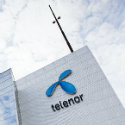Telenor Serves Up a Dodgy Herring in Q2
The Norwegian incumbent has revised down this year's outlook and lacks a decent growth story to excite investors.

Shareholders in Telenor have taken one look at the Norwegian operator's latest results this morning and choked on their pickled herring.
The company's share price opened 4% down in Oslo after shrinkage in organic sales and earnings for the second quarter and a downward revision to the full-year outlook. Having previously expected organic growth of 2% in subscription and traffic revenues, it now sees no likelihood of change. Earnings (before interest, tax, depreciation and amortization) will probably fall by a "low single digit" rate, it said. Earlier this year, the forecast was for 1-3% growth.
Figure 1: Like a Viking Berserker  Telenor's Sigve Brekke wields an axe that must terrify his employees.
Telenor's Sigve Brekke wields an axe that must terrify his employees.
The outlook on profitability is especially disappointing for a company that wields the axe like a Viking berserker. Telenor slashed nearly 10,000 roles last year -- about a third of its entire global workforce -- after cutting more than 6,000 in 2017. The sale of various assets, including subsidiaries in eastern Europe and India, explains much of the damage. But Telenor has also been an outspoken advocate of automation and so-called "digital transformation." Its efforts to become a sleeker, more web-like business will claim about 2,000 jobs annually "toward 2020," it has said.
Investors are understandably upset that such hefty reductions have not led to sustained improvements. Group earnings fell 1.2% organically, to 11.2 billion Norwegian kroner ($1.3 billion), compared with the year-earlier quarter. Telenor blamed that on sales weakness in Thailand and Myanmar, as well as the loss of "high margin" business in Scandinavian markets. Total subscription and traffic revenues were down almost 1% on a purely organic basis, with overall sales up 0.6%, to around NOK28 billion ($3.3 billion).
CEO Sigve Brekke naturally focused on the positives. "The EBITDA margin was 40%, and we saw positive revenue development and effects from efficiency and modernization programmes," he said in a statement accompanying the results. The EBITDA margin does stack up favorably alongside figures from certain other big European telcos. Vodafone managed 31.6% last year across European markets, while Deutsche Telekom turned in 30.8% after adjustment for special factors. And Telenor's margin has risen markedly in the last seven years, from 32.3% in 2012 -- before Brekke's tenure -- to 41.2% last year.
Figure 2: Telenor's Headline Results (NOK Billions)  Source: Telenor.
Source: Telenor.
A concern for shareholders will be the possibility that Telenor's efficiency drive has reached its limits outside Asia, where a planned merger with Malaysia's Axiata could spark a new round of job cuts in future. In the meantime, the Norwegian telco already generates higher sales per employee than any other European operator tracked by Light Reading. At nearly $608,000 last year, the figure was more than twice that of the UK's BT, one of the region's weakest performers on this measure. Telenor was even within reach of Verizon, which -- as the least efficient of the US "big four" -- made per-employee revenues of almost $637,000 in 2018.
Want to know more about 5G? Check out our dedicated 5G content channel here on
Light Reading.
Perhaps more than telcos that remain overstaffed, Telenor could do with a decent growth story to excite shareholders. Next year it plans to launch its first 5G networks. That will also help to keep a lid on costs, providing additional capacity for higher-speed mobile services. But few analysts anticipate a sales increase from upgrading existing smartphone customers. At this year's Mobile World Congress, Brekke touted 5G's potential to fuel growth in new enterprise markets, such as the manufacturing and healthcare sectors.
Judging by Telenor's share price movements, investors have yet to be convinced.
Related posts:
— Iain Morris, International Editor, Light Reading
About the Author(s)
You May Also Like




_International_Software_Products.jpeg?width=300&auto=webp&quality=80&disable=upscale)







